“Duct tape is like the force. It has a light side, a dark side, and it holds the world together.”
Originally uttered by Paul Fix, these words of wisdom have seen many a homeowner through a car repair, roof leak, or electrical problem.
And I’m just like you, believe me. Before every road trip, I reach underneath my driver’s seat to feel that ol’ trusty roll of duct tape stashed underneath. I use EternaBond and several alternatives, like Alpha Systems AlphaBond, on many of my service calls.
RV owners have their own trusty sidekick for RV roof repair tape. It’s called EternaBond. And if you’ve spent more than 5 minutes in the DIY RV world, you’ve heard users extoll its virtues. Let’s put these claims to the test.
Meet the RV Owner’s Emergency Repair Sidekick
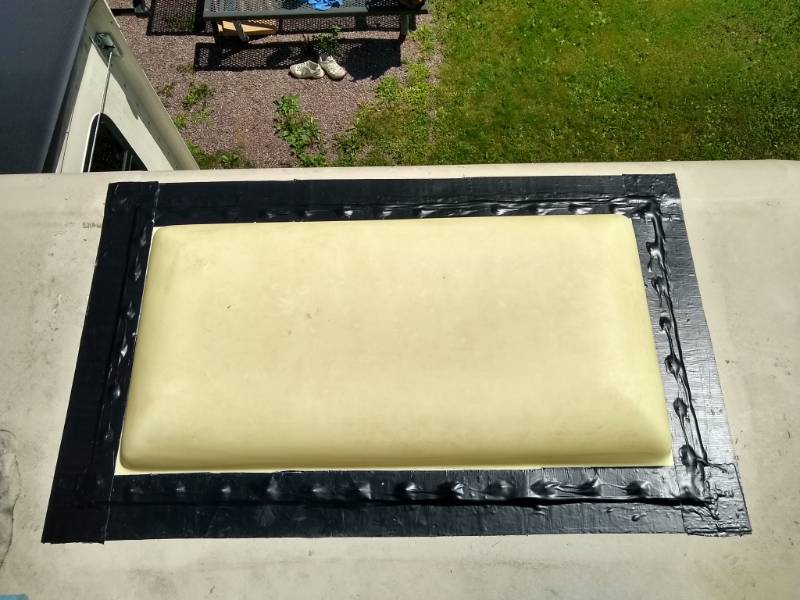
If you’ve spent more than 5 minutes in the DIY RV world, you’ve heard zealous RVers proselytize the salvation of EternaBond tape:
- Got a roof leak? Patch it with EternaBond!
- Got a loose wire? Secure it with EternaBond?
- Need a gasket? Roll up some EternaBond!
- Broke your glasses? Fix ‘em with Eternabond!
- Kids being too loud? Use some —
— well, maybe not that.
This brand lionization leads to a lot of questions. Does EternaBond really work? Is EternaBond worth the price? How long does EternaBond last? Are there worthwhile EternaBond alternatives?
I’ve got some answers. And unlike Jerry B. on some other dingy internet forum, I’ve actually talked to the guys at EternaBond. And their competitors. Plus, I’ve used a few miles of it myself. It’s the industry leader for RV roof repair tape.
So here’s the low-down on EternaBond – and whether you should use anything else.
What Is EternaBond Tape?
EternaBond is a short-hand nickname for a popular RV roof repair tape called EternaBond RoofSeal. It has a thick, gray, gummy pressure-sensitive adhesive and a UV-resistant polymer plastic backer.
EternaBond RoofSeal is normally sold in 2, 4 and 6 inch widths and rolls about 50 feet long. Shelf life is about 5 years.
Popular colors include white, gray and black. It’s on the shelf at pretty much every RV dealer in the country.
And fun fact: You can get a 3-ft wide, 50-ft long roll of the stuff at Best Materials! And that’s not even an affiliate link! I just want to imagine some over-achieving RV owner redoing their entire roof in EternaBond. Makes me chuckle – and shudder.
How Can I Use EternaBond?
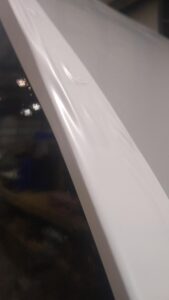
- The most popular use for EternaBond is sealing small tears, holes and patches in RV roofs.
- Some RV owners use 6-inch wide RoofSeal rather than self-leveling sealant as flashing for roof fans, A/Cs, roof vents, fridge roof vents, and other roof penetrations. (Fair warning: This is risky!)
- EternaBond DoubleStick can be used as a sealing and adhesive gasket when installing roof fans, sidewall vents, and other components.
Some RV manufacturers may use EternaBond DoubleStick to attach flexible solar panels to curved rooflines. It’s sticky tape, guys. Your imagination is the limit.
>>> If you’re considering installing solar panels, I’ve got this article on solar panels vs generator that you might enjoy.
>>> Also, check out this guide to what caulks and sealants you need to seal the outside of your RV.
How Does EternaBond Work?
Yes it does. Actually, it works so well that lots of RV manufacturers wrap EternaBond tape over the roof-edge corners underneath the roof-edge aluminum molding. At one time, they used butyl tape. Then they realized EternaBond works better and installs faster.
Today, you’ll find that both DIYers and high-end RV manufacturers wrap their corner seams with EternaBond tape or a similar product.
A partial list of uses includes:
- Waterproofing roof edge seams
- Waterproofing rubber roof seams
- Substitute for self-leveling sealant around roof penetrations and vents
- Gasket for semi-permanent fridge and window installation
- Waterproofing edges of OSB subfloors
But like any product, EternaBond can be applied improperly. Remember: It’s pressure-sensitive!
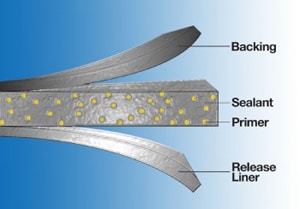
Not to get too super geeky, but there’s a lot going on at the bondline.
- Van der Waal forces create that initial, strong tack.
- With time and pressure, the adhesive flows into microscopic valleys, pits and cracks in the surface, creating a mechanical interlocking bond.
- With high pressure, dispersed primer chemicals in the adhesive wet the surface of the substrate, fusing the repair tape to the roof itself.
But you don’t need to know all this science-y stuff! If you follow the rules below, you’ll be in good hands … or rather, the tape will. I mean, you won’t. You know what I mean.
EternaBond Rules of Thumb!
Use High Pressure
If you want the full benefits of EternaBond, you need to install it with high pressure. Smoothing it over with the heel of your hand won’t do; you need a J-roller, preferably 2 or 3 inches wide, and enough leverage to bear down with most of your body weight.
Hey, if you don’t believe me, listen to the OGs themselves! EternaBond released a bulletin for RVers about this very issue!
Watch the Heat
Like all chemical processes, heat matters. As a rule of thumb, chemical reactions double in speed for every 17 degree Fahrenheit increase in temperature. If the temperature of the surface (remember, that’s surface temperature, not ambient air temperature! In the morning, for instance, surfaces are usually colder than the ambient air) is below 40 degrees, you should probably prime the surface. Or wait for the sun. Or use a heat gun.
Clean Thoroughly
And lastly – or firstly, if you’re applying the tape – if you don’t clean, you’re wasting your time. Surfaces should be wiped down with a non-residue cleaner. Usually, isopropyl alcohol will do the trick. Other solvents, like acetone, can be too harsh for many plastic membranes. And some solvents, like mineral spirits, leave an oily residue that will interfere with the tape bond.
Don’t Stress It!
EternaBond RV tape should be applied so it lays without stress. In other words, don’t stretch it! If you’re using long sections to waterproof your seams, this is a common mistake. The ends of your tape will want to shrink by 1/2″ when it gets cold outside, which causes the tape to lift or separate.
Roll slowly; don’t stretch it!
Should I Use EternaBond Tape Instead of Self-Leveling?
This question is worthy of its own post! In short, I generally recommend that no, you shouldn’t substitute EternaBond tape for self-leveling caulk.
You will find RVers who swear by this hack, but I don’t think it’s the best solution for roof maintenance. If you’re tired of mounting your roof every 2 years to clean off the old self-leveling sealant … then use better sealant (sorry, Dicor!) The cheap stuff has lots of solvents which cause micro-cracks as the sealant cures.
The main problem with using EternaBond instead of self-leveling caulk is that A) it’s really hard to know when it’s failed and B) it’s really hard to replace! (see more below). Water can wick into the bondline and leak into very narrow crevices.
However, RV manufacturers have chosen to use EternaBond as a permanent flashing material at some joints, such as slide-out room roofs and front caps. If you do this, be sure to flash the edges of the tape with caulk, as shown in the picture below:
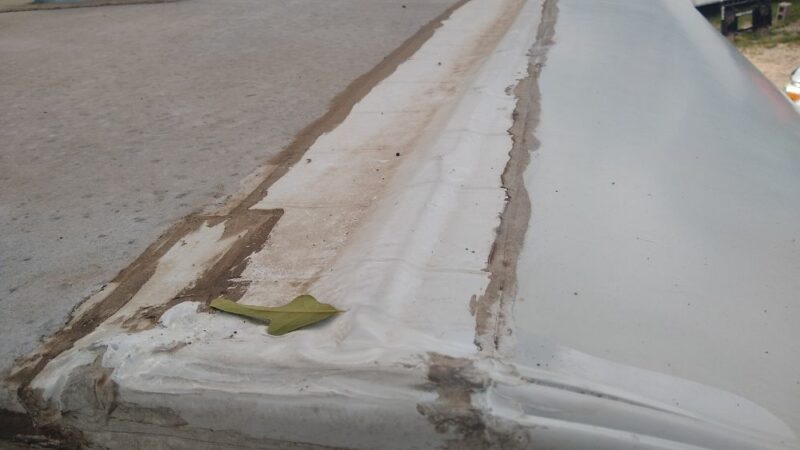
Using EternaBond tape as the sole water barrier is only the tip of the iceberg of RV roof mistakes. Here’s an article on all the ways NOT to reseal an RV roof!
Does EternaBond Fuse to All Surfaces?
The list of what EternaBond can bond to is pretty long.
- EPDM, TOP, most PVC
- Asphalt BURs, coal tar BURs
- Aluminum, galvanized steel, painted metal
- Wood, OSB
- Polystyrene, polyethylene, polypropylene
- Fiberglass
- Brick, concrete
And more! Which is basically 95% of the modern world, so in a sense, EternaBond will bond to almost anything.
But (and it’s a big but), that doesn’t mean all bonds have the same strength.
The tape can have trouble staying stuck to low-surface-energy plastics (polypropylene), really rough surfaces (concrete), and really smooth surfaces (fiberglass).
- Use a primer, like EternaPrime, to improve adhesion to plastics
- Personally, I think tape is a poor choice for concrete. Use a semi-self-leveling flowable sealant.
- Rough up smooth surfaces with 80- or 120-grit sandpaper so the surface has some “tooth.”
How Long Does EternaBond Last?
This, dear reader, I cannot answer for you. I’ve heard some outlandish claims of a 35-year lifespan. Considering that the average lifespan of an RV is about 20 years, I say the extra decade-and-half hardly matters.
If you clean the damaged area carefully, apply the tape with maximum pressure, store your RV inside a garage, and sing to it every night, sure, it can last 20+ years.
(I can personally vouch for at least 7 years on my personal camper.) But I’ve also seen it fail within 2-3 years when exposed to high winds).
But if you just rip n’ stick some EternaBond tape on the roof cap of your RV, exposed to the wind, with no prep cleaning, and it blows off in four days during a heavy rainstorm – well, that’s your fault.
Honestly, I don’t think long-term “lifespan” matters much. You need to check on your RV roof at least once a year anyway. What’s the difference if the tape lasts 10 years or 12 years? EternaBond is ALWAYS a temporary roof patch at best; you need to fix the root cause.
Oftentimes, what fails isn’t the bondline; it’s the tape backing itself. The backer peels away from the adhesive underneath, living the goo without any “body” to protect it.
Which EternaBond RV Roof Repair Tape Should I Choose?
I’ve heard manufacturing plant assembly line workers swear up and down that “the black tape sticks better than the gray stuff!” Or vice versa.
I told them what I’ll tell you: That’s bonkers.
EternaBond is manufactured by a giant company called Royal Adhesives and Sealants LLC. It’s produced in 4-foot wide rolls with all sorts of backers and then trimmed for consumer and commercial applications. More on that later …
All the EternaBond tapes have pretty much the same adhesive. The thickness can vary, though. Regular RoofSeal is 30-35 mil thickness. AlumiBond is only 20 mil. RoofSeal Plus is 60 mil for use on granulated surfaces. For smooth, flat roofs, the mil thickness doesn’t matter much.
Choose whatever type of type works best for your application: RoofSeal, RoofSeal Plus, WebSeal, AlumiBond, DoubleStick, etc. Most RV owners just grab a roll of RoofSeal for everything, and there’s nothing wrong with that.
Do I Need to Prime Before Installing EternaBond?
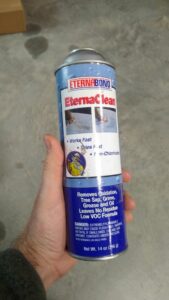
That would depend. The first thing you should do is CLEAN. That’s C-L-E-A-N, people! Spit n’ rub doesn’t do it! Wash, dry, roughen, wash again with isopropyl alcohol, and then don’t touch the area with those oily fingers!
EternaBond is a pressure-sensitive adhesive. It doesn’t bond like, say, Elmer’s glue. It’s tacky, but a complete bond is ONLY formed with pressure, not drying, curing or catalyzing.
So PRESS HARD. If you want to do it the right way, use a 2-inch roller and apply maximum body pressure. But you can use hand pressure in a pinch. Focus pressure around the edges and any seam overlap.
Don’t use EternaPrime as an excuse to be sloppy when cleaning. But if …
- The damaged area cannot be easily accessed and cleaned or …
- You’re installing the tape in cold temperatures under 40 degrees F …
- And/or you’re applying the tape to a low-surface-energy material (such as many plastics) …
Then yes, use EternaPrime.
Can I Use EternaBond on an EPDM or TPO Roof?
RV roofs come in several flavors. Aluminum, fiberglass, EPDM, PVC and TPO are the most common. EPDM and TPO are types of plastic sheets.
Lots of sealant tapes, especially asphalt-based roofing tapes, aren’t friendly with EPDM or TPO. Thankfully, EternaBond – and lots of other PSA tapes – has no compatibility issues.
Normally, the retail tape packaging will warn you of any known chemical compatibility problems. As a rule, EternaBond will stick to any RV roof membrane, including rubber, TPO, and PVC.
How Do I Remove EternaBond?
Four words, my friend: Heat and elbow grease.
Like most adhesives, EternaBond Microsealant will soften with heat. So grab a heat gun or a hairdryer and get to work. Start at one corner and peel back. The adhesive will stretch like cheese. You’ll start sweating. Then swearing quietly. Then your neighbors will hear it. And no, it doesn’t get any easier.
If you’re determined to get all the residue off, you’ll need a strong solvent like gasoline or acetone and a plastic scraper. Enjoy the rest of your afternoon (and possibly evening).
In a pinch, you can just clean and prep the area and lay new EternaBond RoofSeal on top of the residue. It’ll bond to the old sealant just fine. HOWEVER, you should remove the tape backing first! Often, it’s the backer that fails, not the bond!
In fact, these reasons are why some RV techs don’t particularly like EternaBond tape. Sometimes, it is used for permanent installations (like sealing the top of a slide-out), even when it won’t last the lifetime of the RV. Here are the opinions of James, an expert RV tech out of Arizona:
Is EternaBond Worth the Price?
It’s no secret that you can pay for a roll of EternaBond or a nice dinner out, but not both.
You might expect me to say something like, “You get what you pay for,” but the truth is a bit more complicated.
I’m not going to tell you what OEMs pay for EternaBond RV roof repair tape. We bought it by the skid. Our price would just make you angry. You’d send me hate mail, and I’m a person too, OK?!
The usual argument for EternaBond goes like this: “What’s the cost of tape compared to a roof repair?”
That’s a valid point. And if you’re shopping Amazon.com by lowest price for RV roof repair tape, you’d do well to remember that.
But in my experience, other tapes from reputable manufacturers, such as Dicor and Cofair, live up to similar standards. And you can often find them for 20-30% less.
One final thought, fellow RVers: EternaBond is sticky tape. Use it to patch holes and waterproof seams. Please, don’t use it to waterproof your entire OSB underbelly. Or to attach a dinette table to the wall. (You know who you are).
Just always have a trusty roll on hand. Come this year’s April rains, you’ll be thankful.
Can I Use an EternaBond RV Roof Repair Tape Alternative?
So far, I’ve just talked about EternaBond, the brand. It’s the industry leader, and for good reason: It’s powerful stuff. It works.
But if you’ve drunk the Kool-Laid that EternaBond is based on some sort of proprietary alchemy stolen from NASA, then this article is a bucket of cold water in which to dunk your head. I baptize you in the name of science!
There are all sorts of pressure-sensitive adhesives, folks. EternaBond doesn’t own the rights to all of them. I’ve used window flashing tapes that could tear the skin off your fingertips!
Here are some popular competitors to EternaBond:
- Alpha Systems AlphaBond: Works great. I’ve used lots of it. Doesn’t stick well to wet surfaces, though.
- Dicor Di-Seal: Personally, I’ve never tried it. Considering that Dicor is the No. 1 leader of RV roof products, I’d expect it to work pretty well.
- Dicor Seal-Tite: I LOVE THIS STUFF. It molds like putty and sticks like fleas to a dog. It has a woven fleece backing, so it can mesh with a secondary cap sealant, like silicone caulk or butyl tape.
- Cofair Quick Roof Extreme. Unlike EternaBond, it doesn’t have a thick, gummy adhesive. It’s thin and EXTREMELY tacky. You only get one shot! Not as moldable, so best for flat-spot roof repairs.
Spend 15 minutes online, and you’ll find a half-dozen other options:
- Flex-Tape Waterproof Tape
- Kohree RV Sealant Tape
- XFasten RV RSeal
- Beech Lane RV Roof and Leak Repair Tape
- 4EvaSeal
- Gorilla Waterproof Patch and Seal Tape
- And quite a few others. I’m sure Camco has something, too.
I strongly suggest you avoid most of the roofing, flashing and construction tapes found at your local hardware store. Many of these are NOT compatible with EPDM substrates.
Lastly, I’d stay away from all no-name knock-off brands. They make money piggybacking off someone else’s quality, not building up their own.
So, that’s the skinny on EternaBond tape! Yes, it’s a great tool in your arsenal. It’s a great choice for patching temporary roof leaks, organizing stray wire, covering a hole in your sidewall, or a hundred other around-the-RV uses. Just don’t trust any tape as your sole frontline defense!
Leave a Reply